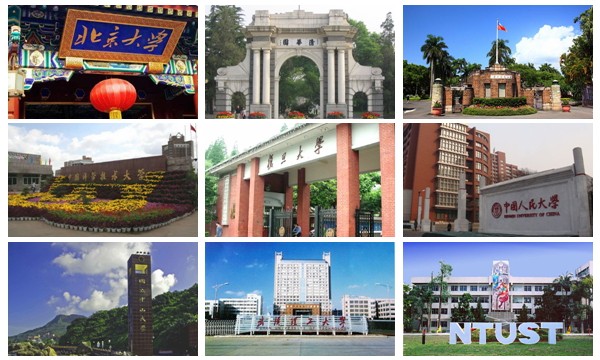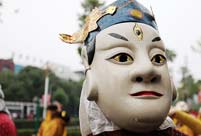 |
| Phil Baty, editor of Times Higher Education BRICS and Emerging Economies Rankings 2014.(Photo provided to People's Daily Online) |
With half of the top 10 positions, China is confirmed as the strongest nation in the world's first ranking of universities in BRICS & Emerging Economies. China is home to almost half of the universities in the table – 44 out of 100.
According to the Times higher education BRICS and emerging economies rankings 2014, is published by the UK's authoritative magazine on Dec 5, Chinese mainland takes the top two places, four of the top 10, and 23 of the top 100 in the inaugural top 100 list, while Taiwan has 21 representatives, with National Taiwan University fourth overall.
"Among the 'BRICS', China's dominance should serve as testament to what can be achieved when a nation puts the development of outstanding research and higher education at the heart of its economic strategy" said Phil Baty, editor of the Times Higher Education rankings.
The success in the BRICS ranking bodes well for China's future development. Its top two universities, Peking and Tsinghua, already compete with the best in the developed world, making the top 50 in the World University Rankings 2013-14: this new table highlights how many more Chinese universities could be poised to join them.
"China has emerged as the strongest higher education nation among the emerging economies - it stands head and shoulders above the other 'BRICS' when it comes to nurturing world-class research universities."
Phil Baty believes that the success comes as a result of clear political leadership and strong financial support for the academy, and should serve as a lesson for the rest of the world.
However, the rankings should also serve as a warning to the other BRICS that they risk losing out in the global race if they do not put further effort and resources into developing their universities to compete with the very best, adds Baty.
Indian institutions make up 10 percent of the list, including nine top 50 places. Its representatives are led by Panjab University (joint 13th), the alma mater of Indian Prime Minister Manmohan Singh. India's specialist institutes of technology take up its next six places, led by IIT Kharagpur (30th). Aligarh Muslim University is 50th and Jawaharlal Nehru University 57th.
Brazil's flagship institution, the University of São Paulo, just misses out on a top 10 position. It is followed by the State University of Campinas (24th), the Federal University of Rio de Janeiro (joint 60th), and Unesp (87th), giving Brazil four top 100 institutions.
Russia has only two top 100 players, with Lomonosov Moscow State University 10th and St Petersburg State University 67th. This low representation is partly explained by the fact that some of Russia’s strongest institutions are too specialized to be included: for example, the Moscow Institute of Physics and Technology and the Moscow State Engineering Physics Institute both make the top 100 in the world in the physical sciences, but cannot be included in the BRICS list.
South Africa boasts the highest ranked university outside China, the University of Cape Town (3rd). The country has five top 100 representatives, with four in the top 50: in addition to Cape Town the universities of Witwatersrand (15th), Stellenbosch (21st) and KwaZulu Natal (45th). The University of Pretoria takes 78th position.
Turkey performs very well, challenging China’s supremacy in the higher positions. It has seven universities in the top 100, including three in the top 10 and five in the top 20. Boğaziçi University takes 5th, followed by Istanbul Technical University in 7th and Middle East Technical University in 9th. Its top 20 representatives are completed by Bilkent University in 12th and Koç University in 20th.
The Times higher education BRICS and emerging economies rankings 2014 are based on the same tried and tested range of 13 distinct and rigorous performance indicators used to create the world rankings, covering all aspects of the modern university’s core missions: teaching, research, knowledge transfer and international outlook. It is the latest addition to a portfolio that has established Times Higher Education as the world’s most respected and most-cited provider of comparative university performance data.
Exclusive Interview With Phil Baty
>> Gov't support beneficial for universities in emerging economies: Times Higher Education
Many of the developing nations have put the creation of world class universities very high up on the list of national priorities, which may lead a shift in the traditional balance of power in global higher education.
>> Diversified higher education system acceptable in BRICS countries: Times Higher Education
Supporting national key universities to become world leading universities before others is acceptable for the purpose of achieving a balanced development in higher education in BRICS and emerging countries.
>> We are keen to give universities in emerging economies visibility:Times Higher Education
Times Higher Education is very keen to give universities in the BRICS and emerging economies visibility and allow their performance to be monitored.
Rankings:
>>Top 10 universities in BRICS and emerging countries


 Heavy cargo flights taking off
Heavy cargo flights taking off In pictures: PLA's digital equipment
In pictures: PLA's digital equipment  Americans mark Thanksgiving Day with parades
Americans mark Thanksgiving Day with parades Self-made farmer billionaire donates 69 villas at hometown
Self-made farmer billionaire donates 69 villas at hometown Demolition of bizarre rooftop villa in Beijing still in progress
Demolition of bizarre rooftop villa in Beijing still in progress Service seminar for E China train attendants
Service seminar for E China train attendants  China's first nude photographer
China's first nude photographer Selected sports photos of the week
Selected sports photos of the week Treasure of Chinese culture- Nuo Dance
Treasure of Chinese culture- Nuo Dance  Youths in Night club: photo story
Youths in Night club: photo story Models dazzle at Int'l Yacht Model Pageant
Models dazzle at Int'l Yacht Model Pageant  Crystal scenery in China: Jilin fog glaze
Crystal scenery in China: Jilin fog glaze  Tianjin holds first pole dance championship
Tianjin holds first pole dance championship  Annual Santa Claus parade held in Canada's Montreal
Annual Santa Claus parade held in Canada's Montreal China's aircraft carrier passes through Taiwan Strait
China's aircraft carrier passes through Taiwan StraitDay|Week|Month